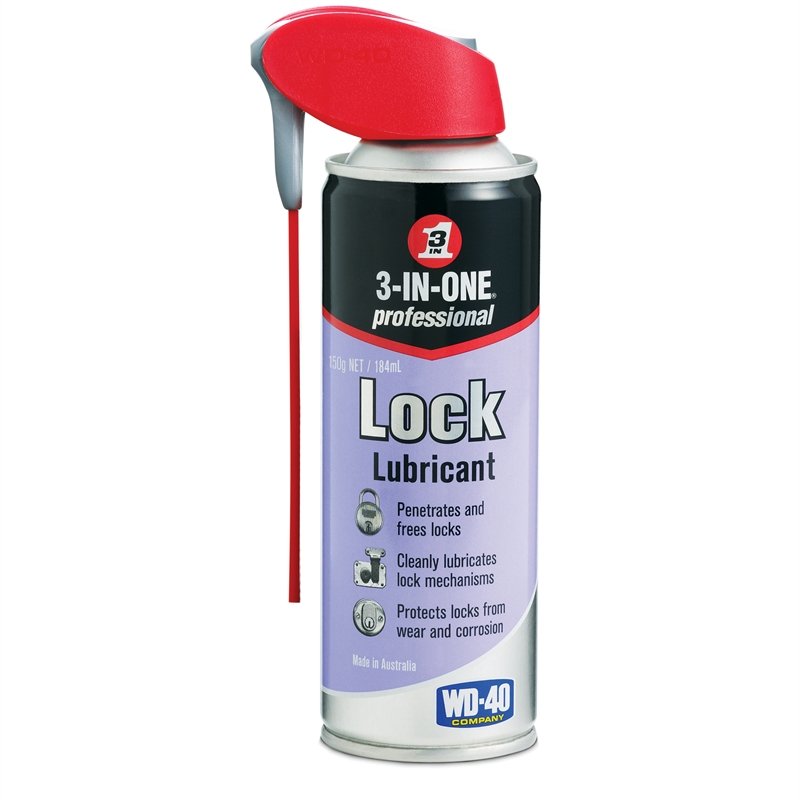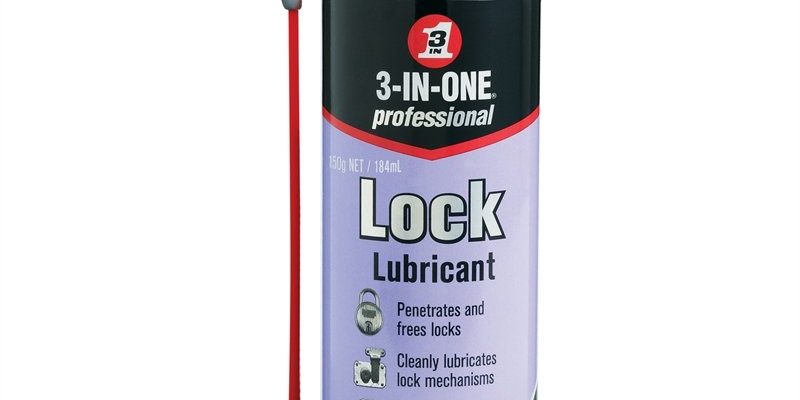
Think of a smart lock like a hybrid between a classic lock and a gadget. Sure, it has a physical bolt and cylinder, but it also hosts circuit boards, micro-motors, sensors, and sometimes a Bluetooth or Wi-Fi chip tucked inside. If you use the wrong lubricant, you could gum up the electronics or cause the battery to drain faster—kind of like putting pancake syrup in a car’s gas tank. So let’s get real about the best smart lock lubricants for electronic mechanisms, and how to keep your lock buttery-smooth without risking a dreaded “low battery” beep or a lockout.
Why Smart Locks Need Special Lubricants
Traditional locks are pretty forgiving when it comes to lubrication. A shot of graphite or squirt of WD-40, and off you go. But electronic smart locks are a different animal. They include sensitive circuit boards, tiny motors, and sometimes lightweight plastics or rubber gaskets mixed in with the metal. The wrong lubricant can mess with these components, just as water spills can fry your TV remote.
Smart lock mechanisms also rely on electrical contacts to read the keypad, sync with your phone’s app, or register the turn of a paired key. Using a thick, petroleum-based grease can short out connections or trap dust—which then leads to sticky buttons or sluggish motors. Even spraying regular oil can cause issues if it drips onto a battery compartment or sensor.
Honestly, it all comes down to this: you want a lubricant that keeps moving parts slick, but doesn’t harm plastic, electronics, or sensitive seals. That’s why most lock manufacturers (like August, Yale, Schlage, and Level) suggest sticking with very specific types of lubes.
Types of Lubricants Safe for Electronic Smart Locks
You might be wondering, “Can I use the same stuff I use for my bike chain?” The short answer is: please don’t. Here are the main choices that work for smart lock mechanisms:
- Dry Teflon (PTFE) spray: This is one of the safest bets. PTFE is a super-slick, synthetic powder that doesn’t attract dust or gum up electronics. It dries fast and creates a nearly invisible barrier. Perfect for tiny gears or pivot points in a motorized smart lock.
- Silicone-based lubricants: These are also pretty forgiving. Silicone sprays protect both metal and plastic from moisture and wear. Just make sure to pick one that dries to the touch (not the greasy kind), so it won’t migrate onto circuit boards or keypads.
- Graphite powder: The classic for manual locks, and still decent for some smart locks—if you use it sparingly. It doesn’t goop up, but it can get messy if over-applied. Avoid dumping it near sensitive battery or code reader areas.
- Specialty lock lubricants: Some brands (like Tri-Flow or Houdini) make lubricants specifically for electronic or combination locks. These are usually a dry formula that’s safe for all lock parts—even buttons, code pads, and moving plates.
One thing to skip: Petroleum oils and greases (like classic WD-40) are a no-go, unless the manufacturer specifically says otherwise. They often attract dust, leak, or degrade plastic seals—leading to stuck keys and signal issues.
How to Apply Smart Lock Lubricants the Right Way
Applying lubricant to a smart lock isn’t rocket science, but it does take a little care and patience. You don’t want to spray blindly or overdo it, since electronic locks need precision. Here’s my go-to process for getting the job done safely:
- Remove the batteries first. Seriously, don’t skip this. Even if you’re just giving the lock a tune-up, pulling the batteries reduces the risk of accidental shorts or error codes while you work.
- Target only the moving metal parts. This means the latch, bolt, and any visible gear or cam. Avoid spraying lubricant directly on circuit boards, keypads, wires, or battery contacts—even a tiny bit of moisture on these can cause glitchy behavior or battery drain.
- Use a straw for precision. Those thin red straws that come with spray cans help you aim the lube exactly where it’s needed—no splatter, no mess.
- Wipe off excess. After applying, work the lock a few times (turn the deadbolt, press the keypad) and then wipe off any drips or stray lubricant with a clean cloth. Less is more.
- Let everything dry before reassembling. If you used a wet lubricant, wait 5–10 minutes so it doesn’t seep into unwanted spots when you put the batteries back in.
If you’re feeling unsure, check your specific lock’s brand website for model-specific tips. Some (like August or Yale) offer downloadable guides and troubleshooting for their electronic smart locks.
Top-Rated Lubricants for Smart Locks (With Pros and Cons)
Let’s talk brands and bottles. You’ll see a ton of choices online or at the hardware store, but only a handful are really dialed in for smart lock mechanisms. Below, I’ve put together a quick comparison table of the most popular options people actually use to keep their smart locks running smooth.
| Lubricant | Type | Safe for Electronics? | Pros | Cons |
| DuPont Teflon Dry Lube | PTFE Spray | Yes | Dries quickly, non-staining, dust-resistant | Requires re-application more often |
| 3-IN-ONE Lock Dry Lube | Lock-specific PTFE | Yes | Easy application, no residue, good for most brands | May not be as water-resistant as silicone |
| Houdini Lock Lube | Specialty Lock Lubricant | Yes | Safe on plastic and electronics, no build-up | Smell is strong at first, can be pricier |
| Tri-Flow Superior Dry Lubricant | PTFE Spray | Yes | Very smooth action, works on all metals, lasts long | Overspray can be messy without straw |
| CRC Silicone Spray | Silicone | Mostly, but avoid battery area | Protects rubber, plastic, and metal | Can be slippery on keypads if over-applied |
I’ve personally found the 3-IN-ONE Lock Dry Lube is great for Schlage and Yale smart locks, while Houdini is a lifesaver for tricky keyless bypass switches. You can’t go wrong with PTFE for most home brands, but stick with silicone sprays if your lock is exposed to lots of rain or humidity.
Common Lubrication Mistakes With Smart Locks
Even with the right product, it’s easy to make mistakes that cause more trouble than they solve. I’ve seen people accidentally wipe out their lock’s battery, fry a sensor, or even void the warranty by picking the wrong lube or spraying in the wrong spot. Here are the classic errors you’ll want to avoid:
- Spraying lubricant directly into the keypad or code reader. Moisture can seep behind buttons and short out the remote electronics—leading to ghost key presses or trouble syncing the lock with your phone.
- Using too much lubricant. Excess lube runs down into the guts of your lock, clogging tiny motors and leaving residue on battery terminals. Always use just a quick burst, work the lock, and then clean up.
- Choosing the wrong formula. Some folks grab whatever’s in the garage—like chain lube, motor oil, or even vegetable oil. These can trap gunk, melt seals, or kill sensitive circuit boards. Stick to dry, lock-safe formulas every time.
- Forgetting to remove batteries before spraying. Lubricant plus live electronics is a recipe for a costly reset or a nice trip to the hardware store for a new lock.
If you ever get sticky keys or sluggish action right after lubing, try gently opening the lock (if possible), drying off visible excess, and letting it air out before trying a reset or battery replacement.
Maintaining Battery Life and Electronic Health While Lubricating
A well-lubricated smart lock should help your code reader, pairing process, and remote sync work faster—not the other way around. The trick is to keep the moving parts friction-free while making sure no lubricant gets where it shouldn’t.
Batteries and smart locks go hand-in-hand. If lubricant gets on the terminals, it might create resistance that makes your lock drain power faster. Plus, certain oils can block proper contact, meaning your keypad might not light up or may refuse to pair with your phone.
Here’s how to keep everything healthy:
- When replacing batteries, always clean the terminals with a dry cloth—don’t use liquids or sprays near electronics.
- Reinstall batteries only after all lube has dried (especially if you used a silicone spray).
- If the lock seems sluggish after maintenance, try a full battery reset—remove batteries, hold down the lock or reset button for 15 seconds, then reinsert batteries to clear out glitches.
If your lock won’t sync with your app or remote after lubing, check for accidental spray on the circuit board or sensor window. In most cases, a gentle clean with a Q-tip and isopropyl alcohol (not water) can help restore normal operation.
Alternatives to Lubrication: Is Cleaning Enough?
Sometimes, we jump straight to lubrication when a simple cleaning would do the trick. Honestly, a lot of issues with smart or universal locks—like sticky keypads, hard-to-turn bolts, or slow battery response—come from dirt or debris, not just lack of lube.
Before reaching for the spray, try this:
- Use a can of compressed air to blow out dust or crumbs from the crevices of the lock, keypad, and battery compartment.
- Lightly wipe the exposed metal and plastic with a soft, dry cloth (never with soap or water around electronics).
- Check for corrosion or stuck debris near the battery terminals—clean as needed before lubing.
If cleaning fixes your sluggish lock, you might only need a tiny amount of dry lube to maintain it—no need to coat everything in spray.
When to Call a Pro: Signs You Need More Than Lubricant
There are times when all the lube in the world won’t fix a failing smart lock. If you notice repeated sync errors, battery drains, or that your lock just won’t pair with *any* remote or app, lubrication isn’t going to be the magic fix.
- If your lock is still grinding or sticking after proper lubrication and cleaning, it might have worn gears or a misaligned motor—both issues need a pro to repair.
- Frequent error codes, failed resets, or battery problems after applying lubricant could mean you’ve got residue on a sensor or circuit board that’s best handled by a technician.
- If you hear odd sounds (like grinding, clicking, or buzzing) every time you enter your code, the lock’s motor might be dying. Get it checked before you burn through another set of batteries.
Don’t be afraid to contact the lock’s manufacturer support—they can talk you through troubleshooting or recommend a local locksmith familiar with electronic mechanisms.
Good smart lock maintenance isn’t just about choosing the right lubricant; it’s about using it the right way, and knowing when you need a little more help.
Closing Thoughts
Keeping your smart lock in top shape is a mix of the right lubricant, a gentle touch, and a little patience. PTFE and dry silicone sprays are usually your safest bets for most brands like August, Yale, and Schlage. Steer clear of drippy or petroleum-based products, and always mind the sensitive electronic bits—especially during battery changes or troubleshooting resets.
Whether you’re taming a sticky deadbolt or keeping your home’s keyless entry smooth, the right maintenance makes sure your code, sync, and remote pairing work every time. A squeaky smart lock is annoying, but a fried circuit board or dead battery is a whole other headache. Regular, careful lubrication (with proper products!) is a quick chore that keeps your smart home secure and stress-free. And if things go sideways? Don’t force it—sometimes calling the pros is the best move.
